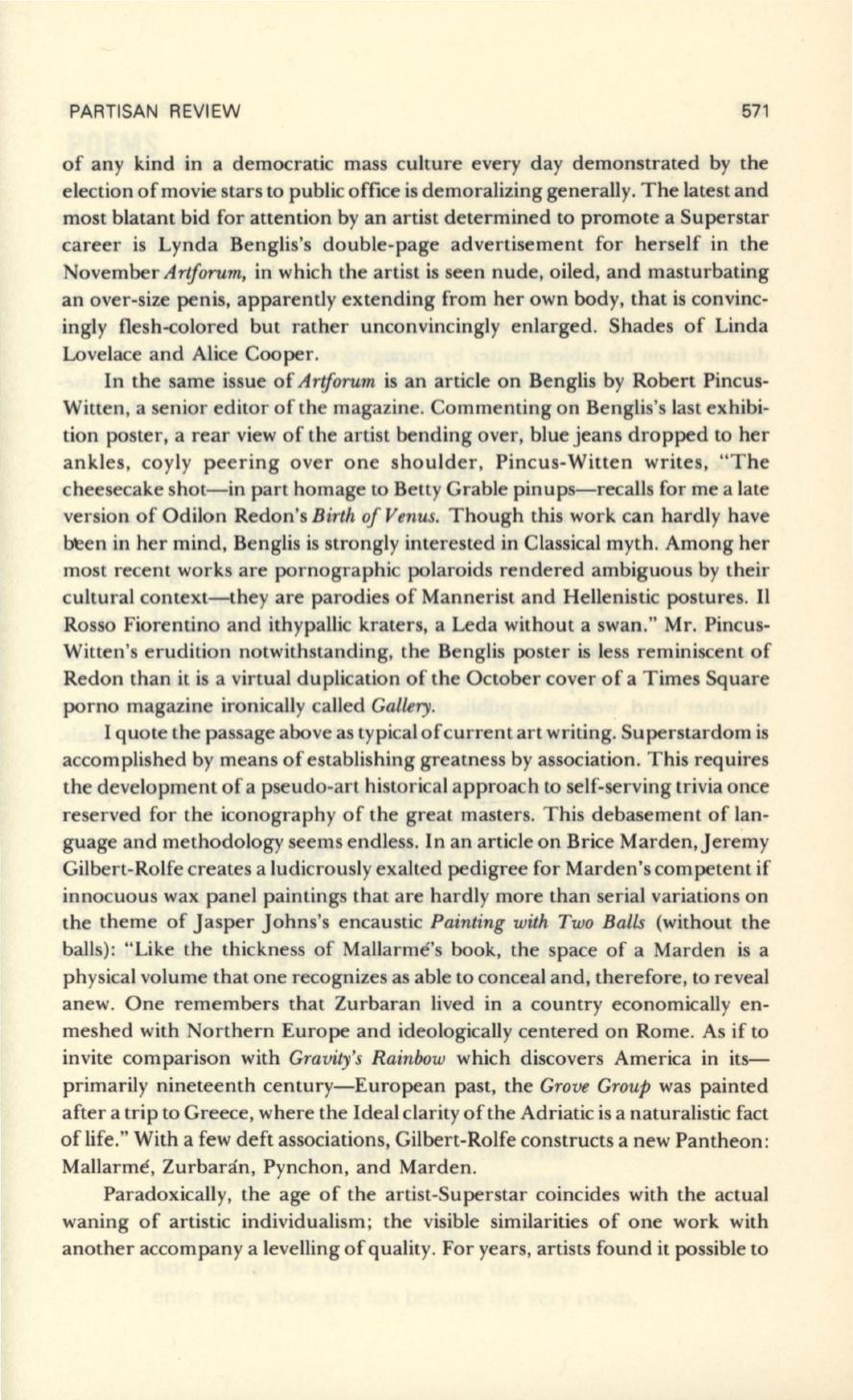
PARTISAN REVIEW
571
of any kind in a democratic mass culture every day demonstrated by the
election ofmovie stars to public office is demoralizing generally. The latest and
most blatant bid for attention by an artist determined to promote a Superstar
career is Lynda Benglis's double-page advertisement for herself in the
November
Artfarum,
in which the artist is seen nude, oiled, and masturbating
an over-size penis, apparently extending from her own body, that is convinc–
ingly flesh-colored but rather unconvincingly enlarged. Shades of Linda
Lovelace and Alice Cooper.
In
the same issue of
Artforum
is an article on Benglis by Robert Pincus–
Witten, a senior editor of the magazine. Commenting on Benglis's last exhibi–
tion poster, a rear view of the artist bending over, blue jeans dropped to her
ankles, coyly peering over one shoulder, Pincus-Witten writes, "The
cheesecake shot-in part homage to Betty Grable pinups-recalls for me a late
version of Odilon Redon's
Birth of Venus.
Though this work can hardly have
b~en
in her mind, Benglis is strongly interested in Classical myth. Among her
most recent works are pornographic polaroids rendered ambiguous by their
cultural context-they are parodies of Mannerist and Hellenistic postures. II
Rosso Fiorentino and ithypallic kraters, a Leda without a swan." Mr. Pincus–
Witten's erudition notwithstanding, the Benglis poster is less reminiscent of
Redon than it is a virtual duplication of the October cover of a Times Square
porno magazine ironically called
Gallery.
I quote the passage above as typical ofcurrent art writing. Superstardom is
accomplished by means of establishing greatness by association.. This requires
the development of a pseudo-art historical approach to self-serving trivia once
reserved for the iconography of the great masters. This debasement of lan–
guage and methodology seems endless.
In
an article on Brice Marden,Jeremy
Gilbert-Rolfe creates a ludicrously exalted pedigree for Marden's competent if
innocuous wax panel paintings that are hardly more than serial variations on
the theme of Jasper Johns's encaustic
Painting with Two Balls
(without the
balls): "Like the thickness of Mallarme's book, the space of a Marden is a
physical volume that one recognizes as able to conceal and, therefore, to reveal
anew. One remembers that Zurbaran lived in a country economically en–
meshed with Northern Europe and ideologically centered on Rome. As if to
invite comparison with
Gravity's Rainbow
which discovers America in its–
primarily nineteenth century-European past, the
Grove Group
was painted
after a trip to Greece, where the Ideal clarity of the Adriatic is a naturalistic fact
oflife." With a few deft associations, Gilbert-Rolfe constructs a new Pantheon :
Mallarme, Zurban(n, Pynchon, and Marden.
Paradoxically, the age of the artist-Superstar coincides with the actual
waning of artistic individualism; the visible similarities of one work with
another accompany a levelling of quality. For years, artists found it possible to


